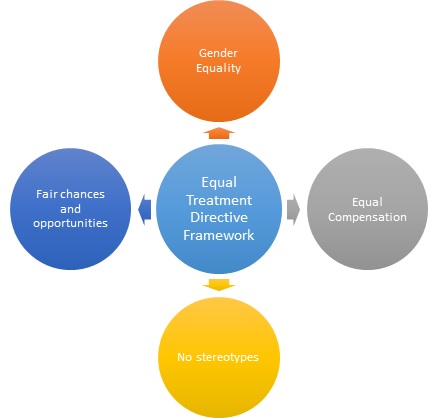- Business Concepts ›
- Human Resources (HR) ›
- Equal Treatment Framework Directive
Equal Treatment Framework Directive
Definition, Importance & Example
This article covers meaning & overview of Equal Treatment Framework Directive from HRM perspective.
What is meant by Equal Treatment Framework Directive?
Equal Treatment Framework Directive highlights the importance of employees being treated equally in an organization. As said equality can be in many forms, Equal Treatment Framework Directive highlights the treatment of employees in an equal manner irrespective of their cast, creed and gender. Equality is a broad term and can be defined in various aspects.
The various acts that it combines are Racial Equality Directive 2000, Equality act 2006 and the equality Act 2010 in UK. Equal treatment act also considers treating employees equally irrespective of what they think, their physical stature and their income level. Equality is not easy to implement, it needs to overcome a lot of personal biases. Especially in organizations, gender discrimination is very rampant. Women are considered to be less abled than the men to handle higher positions in organizations. This framework helps in combating that problem and provides equal employment opportunity.

Importance of Equal Treatment Framework Directive
Equality in organizations is a very important aspect keeping in consideration the growth and productivity of them. Organizations cannot be biased in any terms. Biases are the basis of all sorts of conflicts whether they are employee –employee or employee-employer. Equality treatment directive framework helps in addressing many organizational issues and have equality impact assessment for equal treatment. Especially when it comes to performance appraisal process and also taking decisions for promotions, there are many types of biases that affect the process. To name few, halo effect, stereotyping etc. are very common. If there is a check on equality, at least people / employers would try to be a bit careful while conducting such processes and would try to overcome the personal biases they have against the employees. As we see, now a days top positions being acquired by women in many organizations that too esteemed and well known organizations, this is all because of the equality being considered as top most priority in organizations. Equality in gender is giving the abled women also the same positions and compensation that an equally abled male gets. Similarly, a disabled should be treated equally and should be respected in terms of being a differently challenged person. Equality is mandatory for a country’s development too.
Equal Pay Act, 1963 can be considered as an equal treatment framework directive, when only organizations or the work places are considered. But equal compensation act only considers equality in giving compensation to the employees irrespective of their genders. This act is now a part of Wages code bill.
Example of Equal Treatment Framework Directive
Equality in workplaces is very rampant now a days. We see many organizations considering diversion and inclusion as major part of their recruitment process. Tata Steel had a provision for LGBT even before section 377 was abolished from India. We have seen Chanda Kochhar and Indra Nooyi holding the highest of positions in esteemed institutions like ICICI bank and PepsiCo. Differently challenged people are given due respect and are allotted work according to their comfort. Maternity benefit act is one of the biggest employees how women are respected and are given due consideration for they being on the family way. No doubt paternity acts are also now very visible in many organizations. In short everything exemplifies how employees are respected and treated equally in spite of the differences.
Hence, this concludes the definition of Equal Treatment Framework Directive along with its overview.
This article has been researched & authored by the Business Concepts Team which comprises of MBA students, management professionals, and industry experts. It has been reviewed & published by the MBA Skool Team. The content on MBA Skool has been created for educational & academic purpose only.
Browse the definition and meaning of more similar terms. The Management Dictionary covers over 1800 business concepts from 5 categories.
Continue Reading:
What is MBA Skool?About Us
MBA Skool is a Knowledge Resource for Management Students, Aspirants & Professionals.
Business Courses
Quizzes & Skills
Quizzes test your expertise in business and Skill tests evaluate your management traits
Related Content
All Business Sections
Write for Us